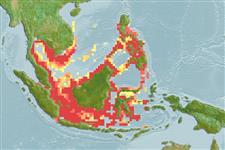>
Clupeiformes (Herrings) >
Engraulidae (Anchovies) > Engraulinae
Etymology: Stolephorus: Greek, stole, -es = garment + Greek, pherein = to carry (Ref. 45335).
More on author: Bleeker.
Environment: milieu / climate zone / depth range / distribution range
Ecologie
marien; brak water; amfidroom (Ref. 51243); diepte 0 - 50 m (Ref. 189). Tropical; 17°N - 11°S, 98°E - 127°E (Ref. 189)
Western Pacific: Gulf of Thailand and Java Sea. Indian Ocean records probably based on Stolephorus baganensis or Stolephorus insularis.
Grootte / Gewicht / Leeftijd
Maturity: Lm ? range ? - ? cm
Max length : 9.5 cm SL mannelijk / geslacht onbekend; (Ref. 189)
Dorsale stekels (totaal): 0; Anale stekels 0; Anale zachte stralen: 17 - 18. Belly with 6 or 7 small needle-like pre-pelvic scutes; a small pre-dorsal spine and another spine on the pelvic scute. Maxilla pointed, reaching to or beyond hind border of pre-operculum, the latter concave, indented near maxilla tip. Anal fin short, with origin below about middle of dorsal fin base. A double pigment line on back both before and behind dorsal fin.
A schooling species found in coastal waters. Adults frequently visit the lower reaches of mangroves where neritic conditions are present (Ref. 43081). More specimens and data needed.
Levenscyclus en paargedrag
Maturiteit | Voortplanting | Paaien | Eieren | Fecunditeit | Larven
Wongratana, T., T.A. Munroe and M. Nizinski, 1999. Order Clupeiformes. Engraulidae. Anchovies. p. 1698-1753. In K.E. Carpenter and V.H. Niem (eds.) FAO species identification guide for fishery purposes. The living marine resources of the WCP. Vol. 3. Batoid fishes, chimaeras and bony fishes part 1 (Elopidae to Linophrynidae). FAO, Rome. (Ref. 9822)
Status op de Rode Lijst van het IUCN (Ref. 130435)
Gevaar voor de mens
Harmless
Gebruik door de mens
Visserij: visserij voor eigen gebruik
Meer informatie
ReferentiesAquacultuurAquacultuurprofielKweeklijnenGeneticaElectrophoresesErfelijkheidZiektesVerwerkingNutrientsMassaconversie
Tools
Speciale rapporten
Download XML
Internetbronnen
Estimates based on models
Preferred temperature (Ref.
123201): 28.2 - 29.1, mean 28.8 °C (based on 302 cells).
Fylogenetische diversiteitsindex (Ref.
82804): PD
50 = 0.5000 [Uniqueness, from 0.5 = low to 2.0 = high].
Bayesian length-weight: a=0.00537 (0.00262 - 0.01101), b=3.17 (2.99 - 3.35), in cm total length, based on LWR estimates for this species & (Sub)family-body (Ref.
93245).
Trofisch niveau (Ref.
69278): 3.3 ±0.4 se; based on size and trophs of closest relatives
Weerstandsvermogen (Ref.
120179): Hoog, minimale populatieverdubbelingstijd minder dan 15 maanden (K>1).
Fishing Vulnerability (Ref.
59153): Low vulnerability (10 of 100).
Nutrients (Ref.
124155): Calcium = 472 [141, 1,252] mg/100g; Iron = 2.49 [1.36, 4.42] mg/100g; Protein = 19.3 [17.5, 21.2] %; Omega3 = 0.478 [0.207, 1.122] g/100g; Selenium = 45.4 [19.8, 97.1] μg/100g; VitaminA = 38.5 [8.5, 162.7] μg/100g; Zinc = 2.68 [1.74, 3.99] mg/100g (wet weight); based on
nutrient studies.
